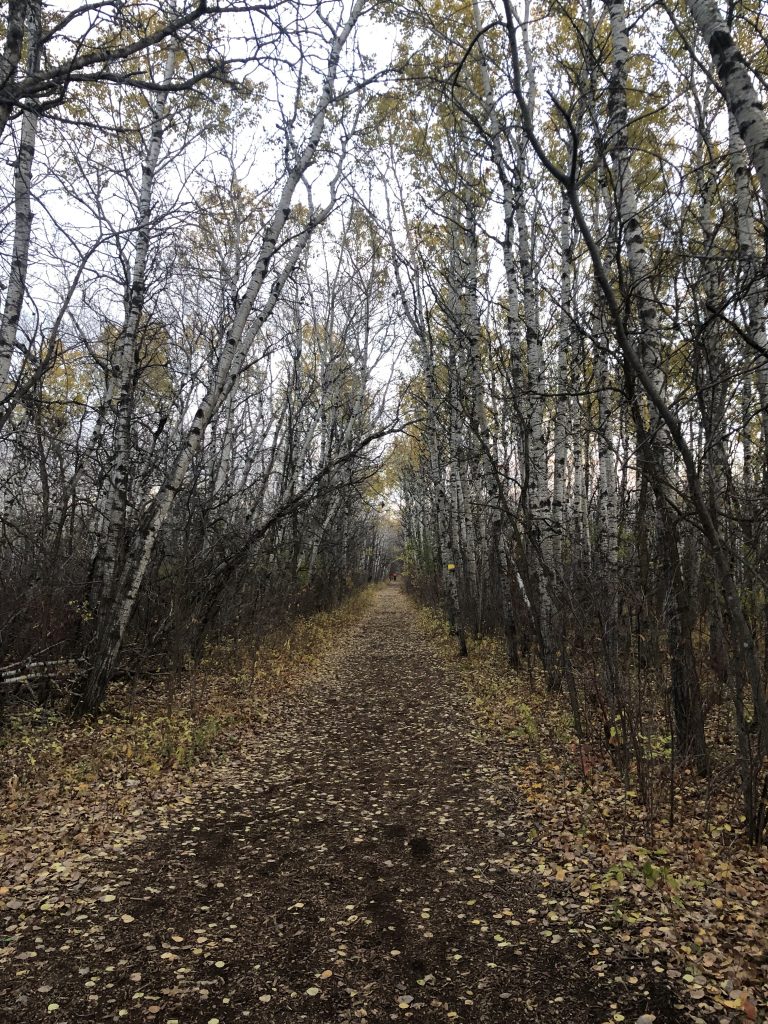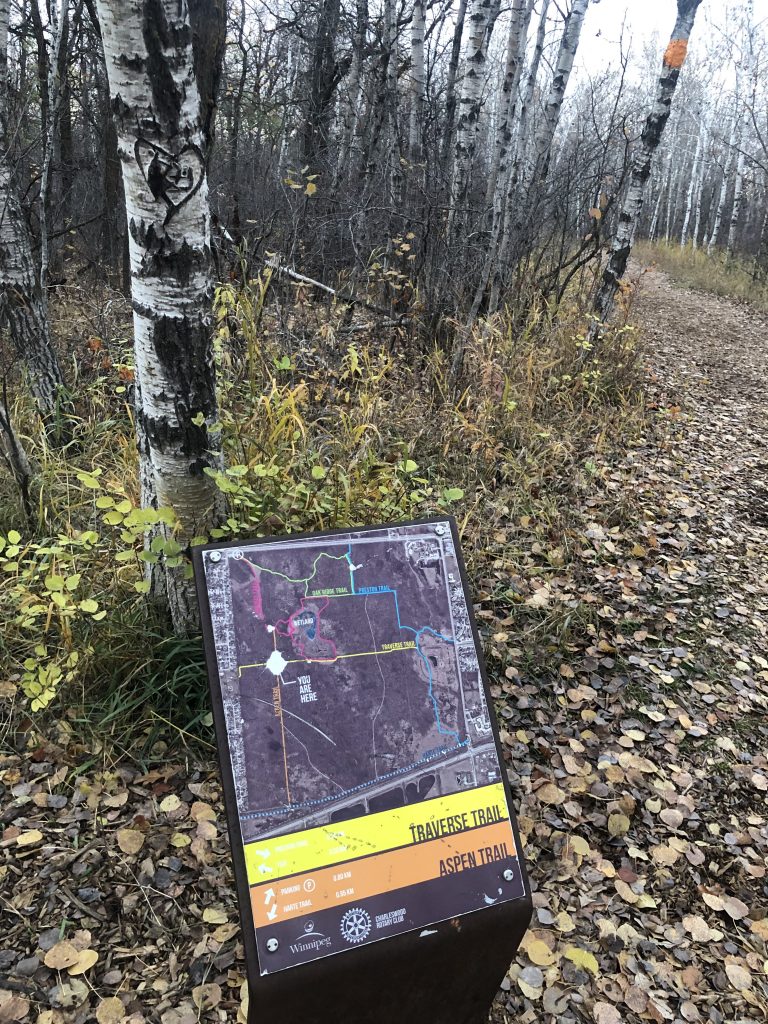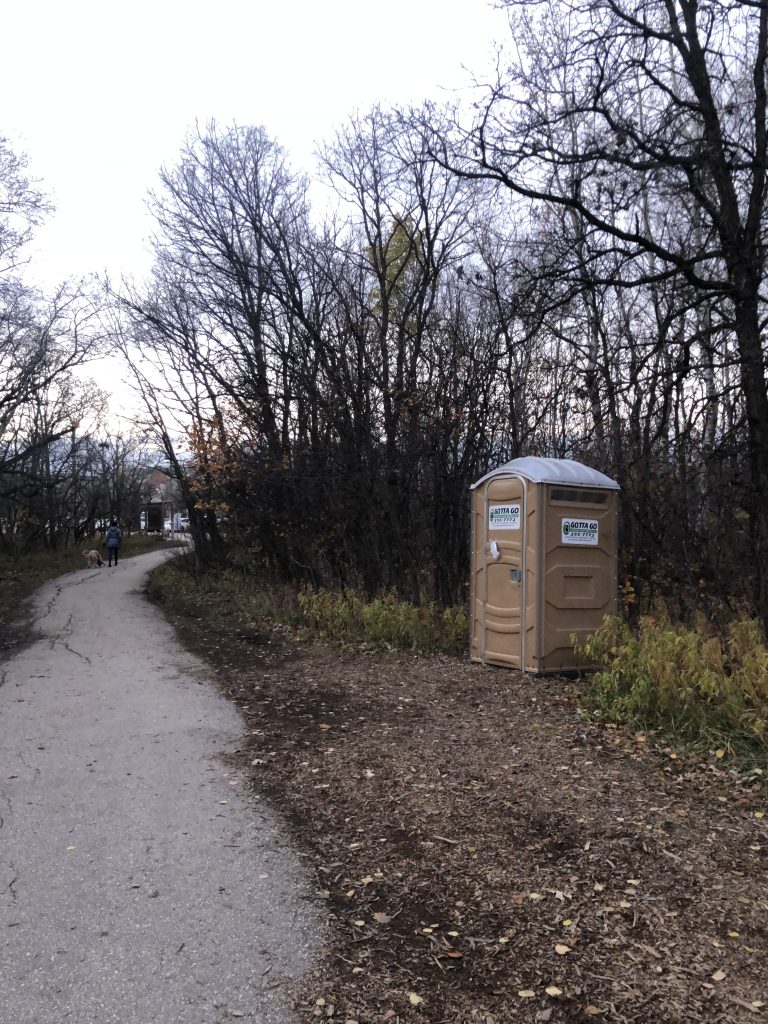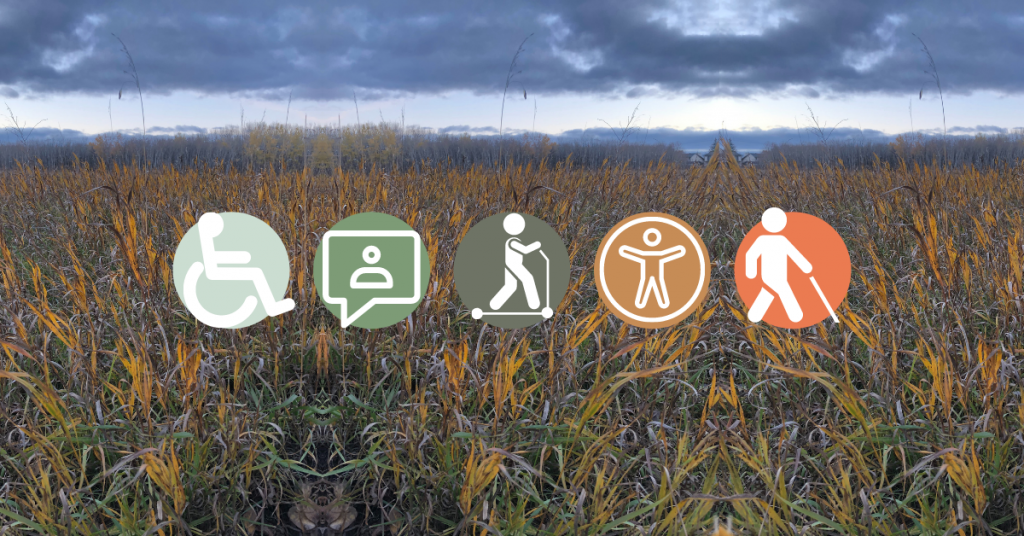A look into the accessibility of Winnipeg’s forests and outdoor spaces
Listen to the article:
Disclaimer: I do not have a disability and am privileged to be able to visit spaces without needing to ensure they are accessible. At times in this article, I share my experience visiting places to help describe them. My experience visiting these spaces is not universal, and I hope to bring attention to the issue of outdoor accessibility by amplifying the voices of people with disabilities.
Cold weather and harsh conditions don’t generally phase Winnipeggers. On this weekday morning in early January, it is snowing and feels like -26C, but by 10 a.m. the cars of Manitobans willing to venture into the cold have filled the parking lot at the Assiniboine Forest.
Schools don’t open until next week, so in addition to the usual crowd of retired folk and people walking their dogs, groups of parents are pulling sleds full of bundled-up kids and juggling coffees. The forest attracts people from all walks of life, but for one group of the Manitoban population, visiting these outdoor spaces is difficult.
People who have disabilities in Winnipeg know the reality of our harsh winters better than most. They are familiar with challenges people without disabilities may not notice that are exacerbated by unplowed sidewalks, delayed public transportation, and the bitter cold. These obstacles make everyday tasks difficult, including using outdoor spaces.
But even when there’s no snow, people with disabilities are often excluded from outdoor activities.
While many people can walk, cycle, run, or ski through the beautiful parks and forests the province offers, some people with disabilities are limited in where they can go. Many Manitobans live with disabilities, and that is why making spaces accessible is so important. Accommodations are not limited to mobility aids, there are also rails, benches, high-contrast signs and more that are needed to ensure everyone can access these spaces.

Why visit outdoor spaces?
Visiting outdoor spaces is important for physical and mental health. With the pandemic limiting indoor activities, getting outside has become even more important.
People who exercise outdoors and try to limit screen time have better mental health than those who don’t, according to a July 2020 study from Statistics Canada.
Spending time outdoors reduces stress, increases happiness, creativity, and even makes people feel kinder and “more alive,” explains Jill Suttie in an article from the University of California.
Two of the most popular outdoor locations in Winnipeg — FortWhyte Alive and the Assiniboine Forest — have reported a spike in visitors since the pandemic started.
“When you spend time outside, it just feels good, and the science backs it up,” said Carolyn Townend, the communications and brand manager at FortWhyte Alive. “Studies show that visiting a forest has real, quantifiable health benefits.”
Forests offer people a great space to connect with their friends or family, get some exercise, clear their heads, find inspiration, or just get out of the house.
While people are realizing the importance of having outdoor spaces, many, if not most outdoor areas, including forests, are not as accessible as they could be.
What makes a space accessible?

Nearly one out of every six Manitobans has a disability, and they all have different requirements for accessing and enjoying spaces.
Disabilities encompass everything, including vision loss, mobility issues, chronic pain, intellectual developmental, mental, and learning disabilities. There is a wide range of needs and no single solution for making spaces accessible.
Joelle Robinson lives with multiple sclerosis and has mobility challenges. She uses a scooter to get around her community.
“Accessibility needs to be a continuum. It can’t just be one thing […] for example, a disabled parking spot is great, that’s fine, but no one has thought of the next step — how does the disabled person, whether they’d be in a wheelchair or using a walker, how do they get out of that spot onto the sidewalk? And then once they get onto the sidewalk, how do they get from the sidewalk to where their activity is?”
Robinson said her ideal outdoor space would include the following features:
- An appropriate accessible parking spot with space to enter and exit the vehicle on either side
- Ramps up to the curbs
- A wide (ideally concrete) sidewalk without interlocking brick or other hazards
- Wide trails with a large turning radius
- Guardrails and handrails on steep portions of the trail that do not block the view for people who use wheelchairs or other mobility aids
- Clear signage with high contrast at an appropriate height for people standing or seated in wheelchairs
“There are many small details that need to be considered. But those small details are so important,” said Robinson.
Accessibility is important, but so is the feeling of being submerged in nature. After all, that is the whole point of visiting a forest. Rosalie Best, who uses a motorized wheelchair, understands this.
“I like when I am really in the forest. And I know it’s harder to get that feeling when a forest is like accessible, right?” said Best.

Because each person with a disability has different needs, consulting with the right people when designing any indoor or outdoor space is essential.
“They should be consulting with people who have disabilities, not just experts who say they’re accessibility trained. Until people live with it, they don’t understand it,” said Robinson.
Robinson explained she must do research before she goes to public spaces. She reads reviews, checks forums, or even has her husband check out the space to ensure it’s accessible.
Accessibility at the Assiniboine Forest
History
In 1920, the town of Tuxedo planned to develop a large plot of land that had remained untouched as the town grew around it.
The developers plotted the new development and established roadcuts through the forest to one day become roads. The stock market crashed in 1929 before they could finish, and all development stopped.
As the community joined Winnipeg, city councillors decided it would be best to keep the land undeveloped. In 1973, when individuals and concerned citizen groups spoke up, the area was preserved as a municipal nature park.
Today, those roadcuts mark a portion of the trails through Assiniboine Forest, Canada’s largest urban natural forest. The beautiful aspen-oak forest spans over 285 hectares and has 18 kilometres of multi-use trails.
When I first walked past the information signs at the Chalfont Road entrance, I heard birds chirping and the tiny paws of the squirrels and rabbits scurrying around on the forest floor. During a few lucky visits, I’ve stumbled across deer leaping through a meadow, ducking behind trees, or nibbling on a plant.
The forest is vast and shows off many different landscapes. At times the trees become sparse, and prairie grass in a small meadow becomes visible. A portion of the wetland has a boardwalk where you can travel over water.
It is easy to visit the forest every day and find something interesting each time.
The city owns the forest, but the Charleswood Rotary Club (CRC) has taken care of the Assiniboine Forest for over 30 years.
“Given that we’re in this time of climate change, it’s even more important that we retain the green areas we have,” said Jack Wilson, a member of the CRC.
Assiniboine Forest is currently not very accessible. One paved trail enters the forest, makes a mile-long loop, and then exits on the same path. The other paths are primarily woodchipped and narrow.
The CRC is working with consultants to make the forest more accessible.

In 2018, the CRC commissioned architectural students from the University of Manitoba to study the forest. The study included putting up infrared tracking devices to monitor the number of people visiting the forest. They registered over 270,000 visitors per year, and they believe these numbers have skyrocketed since the pandemic, explained Wilson.
Wilson interviewed visitors and discovered that people visit from all over Winnipeg. People from rural Manitoba visit after shopping or going to appointments in the city. One person he interviewed even dropped by on their way from England up to Churchill.
When I visited the forest in the fall of 2021, I noticed a few things that may be accessibility issues. The first was that the forest maps were scratched out and hard to read, making it easy for someone to get lost. The small parking lot was full and had no designated accessible parking spots. The only washroom available was a single portable toilet; it was not wheelchair accessible, and it closed for the winter.

The CRC is aware of these issues and recently released a plan to make the forest more accessible. These plans include more paved paths, a washroom, new signage, and a new or upgraded parking lot.
“The intent is not to change the integrity of the forest at all,” said Wilson.
Most of the community received this news enthusiastically. They were looking forward to upgrades that would benefit most people. Everyone goes to the washroom, so having one in the forest means people can spend more time there. Paved paths are pleasant to walk on and push strollers on, and a large parking lot means a less stressful experience for all visitors.
Others opposed these upgrades; they argued that there could be adverse effects on the wildlife and ecosystem of the forest. They wanted to leave the forest as close as possible to its natural state.
Community members were concerned that more waste would be left behind if more people visited the forest. They argued that not everyone has to access the forest; there are other, more accessible options, such as Assiniboine Park, only a few kilometres away. One resident created a Change.org petition to halt the upgrades to the forest, and this petition received 1,619 signatures.
“Any kind of announcement for things being accessible, there’s going to be a group kind of against it, just because there’s a misunderstanding of why accessibility is important,” said Best.
The CRC listened to these concerns, met with the neighbours who opposed the upgrades and clarified and modified their plan as a compromise, according to an update on the Change.org petition. These changes include reconsidering and researching alternatives for surfaces and putting off the construction of an interpretive centre.
Accessibility at FortWhyte Alive

A short distance away from the Assiniboine Forest is FortWhyte Alive. FortWhyte Alive describes itself as an “environmental, education and recreation centre.”
“FortWhyte Alive is a chance to immerse yourself in the outdoors without leaving the city. We’re Winnipeg’s nature oasis — the perfect place to explore, wander and discover something new,” said Carolyn Townend, the Communication and Brand Manager at FortWhyte Alive.
To get to FortWhyte Alive, I had to drive down McCreary Road. While driving, I got a glimpse of the landscape. I saw typical prairie vegetation with the addition of trees on some properties and out behind some houses.
Once I got closer to FortWhyte Alive (when approaching from the north), I caught a glimpse of bison wandering around a field, an unusual sight, especially in a city. When I arrived at FortWhyte Alive, the taxidermy bison greeted me at the entrance of the Alloway Reception Centre.
An $8-10 admission fee is required to get into FortWhyte Alive. In some ways, this makes it less accessible than the Assiniboine Forest, but in other ways, it is more accessible: it has accessible washrooms and parking, personal maps, and more.
Townend explained that the admission and membership revenue allow FortWhyte Alive to provide reduced-rate or free environmental education programming to youth. Indigenous People have not been charged entry fees since December 2021.
The well-maintained trails at FortWhyte Alive are made of natural materials local to the area, including limestone, wood chips, and wood used to construct boardwalks. Because these materials are local and natural, they do not cause significant environmental harm or disrupt wildlife.

“Our goal is to find the happy medium between preserving the natural beauty of this reclaimed place while making it as accessible as possible,” said Townend.
Washrooms are another critical aspect of accessibility. Everyone has had “to go” while in a public space, and no one should have to cut their excursion short because they had to use the facilities that weren’t there or weren’t accessible.
FortWhyte Alive has wheelchair-accessible washrooms in all buildings. In 2017, FortWhyte Alive received a $21,000 grant for their Barrier Buster’s Project to make the Alloway Reception Centre and Field Station more accessible. They used the grant to install automatic doors for both buildings, significantly improving accessibility.
They also offer wheelchair and stroller rentals, allow service pets with the proper documentation, and have step-free access to all buildings.
When I began my walk at FortWhyte Alive, I started by heading toward a lush forest. As I continued, the trees thinned out and revealed Manitoba’s beautiful prairie landscape, including bison, prairie dogs, and other wild critters.
Each time I was curious about something, whether it was about a type of tree, specific displays, or buildings, there was always a sign nearby to explain — at a height suitable for people using wheelchairs.

FortWhyte Alive seems to be making a substantial effort to ensure their areas are accessible. Still, people with disabilities are the only ones who can determine if those efforts have been fruitful.
What does the government say?

On Dec. 5, 2013, the Manitoba Government created the Accessibility for Manitobans Act. This legislation aims to prevent and remove barriers for people with disabilities. The Act consists of five standards on areas of daily living: customer service, employment, information and communication, built environment, and transportation.
The Accessibility Advisory Council (AAC), a Manitoban council made up of people from the disability community and other affected stakeholders wrote the standards in each section.
Forests and other outdoor spaces fall under the built environment accessibility standard, which covers sidewalks, docks, exterior signs, and bike paths. The AAC writes that the standard aims to “improve the health, independence and well-being of people with disabilities.” The AAC also acknowledges that past outdoor spaces were built with barriers to people with disabilities.
The standard covers a lot and does not go into in-depth details on trails. It states that outdoor spaces with trails such as forests should use signs to provide information on the usability of the trail. The signs should include the length of the trail, type of surface, average and minimum trail width, average and maximum running slope, cross slope, and the location of any amenities provided.
A note in the standard also recognizes that people have many uses for trails, and some cannot be made accessible to all people without entirely changing the purpose of the excursion. For example, making a rock-climbing wall wheelchair accessible, altering a difficult path used as a fitness challenge, or opening a wilderness hike to vehicles makes these activities more accessible, but also changes the point of the activity.
“To remove the obstacles on these trails or to reroute the trails around the obstacles would fundamentally alter the function or purpose of the trails,” states the design notes in the section on beach routes and recreational trails.
This note is only regarding certain trails; others may benefit from becoming more accessible. For example, the Assiniboine Forest is a mostly flat leisure trail that could become more accessible without compromising its purpose. The note also mentions how important it is to be mindful of nature. Typically using construction machinery is fine, but it may disrupt the ecosystem; the same goes for certain materials such as cement or asphalt.
Just as consulting people with disabilities is beneficial, consulting environmental engineers, architects, or people specializing in outdoor spaces is crucial when planning to upgrade a natural space.
The Act also states that every organization should have an accessibility plan they update at least every two years. The requirement to update the plan ensures organizations follow current practices and continue to consider accessibility.
“There’s a lot of performative action from the government with laws or acts that no one necessarily enforces. So, it’s like we’re telling people ‘Do this to be accessible, but if you don’t, that’s fine,’” said Best.
Robinson said legislation federally and locally, like the Accessibility for Manitobans Act is important. But the shift must happen with people’s perceptions, the implementation of features, and understanding how important they are.
“This is the hard part, it’s kind of a lead the horse to water, but you can’t make them drink situation,” she said.
The standard has a special section for snow clearing, an issue Manitobans know all too well. The section says snow should be cleared promptly to make walkways and paths accessible.
“It’s like an ecosystem, an ecosystem of accessibility, you know, like you have to be prepared and get snowplows out there,” said Best.
Most Manitobans are familiar with the harsh winters and their impacts on our roads, sidewalks, and trails. Still, for people with disabilities, an abundance of snow may make the difference between enjoying the outdoors or being trapped inside.

“In the winter, recreational activities are not really realistic, because you just can’t go to some of these places…like to go to a forest, forget about it, because it’s not clear, it’s icy, and it’s just not going to happen,” said Robinson.
Townend said FortWhyte Alive staff work tirelessly to ensure the trails stay plowed and accessible even through their snowiest months.
What should be done moving forward?
Accessible spaces benefit everyone. People with disabilities should have access to natural spaces. People without disabilities, could develop a disability or might want to access spaces with a friend or family member who is, or may become, disabled. Some children prefer a stroller over walking, or someone may have an elderly friend who needs to take breaks at benches during walks.
Making spaces accessible and keeping the environment as close to its natural state as possible is not mutually exclusive. Both Assiniboine Forest and FortWhyte Alive have found ways to compromise.
Accessible spaces are not a one-time thing. Consistent upgrades on the trails, paths, signage, and everything else are needed for spaces to remain safe and accessible.

Many spots in Manitoba have been trying to become more accessible. Manitoba beaches, including St. Malo and Birds Hill Provincial Parks, have installed mobility mats, which allow people who use mobility aids to access swimming areas and get close to the water. The government has been improving the accessibility of playgrounds, public washrooms, and trails. Additionally, as part of the Seine River Greenspace Enhancement Project, the group Save Our Seine has installed an accessible dock at the Seine River.
Not every outdoor trail or activity can be made accessible without dramatically changing the environment, but many can.
When upgrading these outdoor spaces, people with disabilities should be consulted. The necessary features should be installed to allow as many people as possible to enjoy the outdoors and reap the benefits to their physical and mental health.
Accessibility limitations should not prevent any Manitobans from braving the cold.
